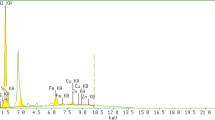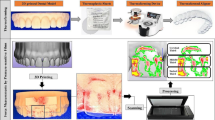Abstract
The aim of this study was to evaluate the microstructural quality of noble alloy castings from commercial dental laboratories using the wiping–etching method as a simple method for quality control. In total, 240 castings from two noble alloys (AuAgCuPt and AuPtZn) were taken from a day's production of five different dental laboratories. The casting quality was evaluated by determining the grain size and by assessing the number and size of shrinkage cavities after acidic etching of the alloy surfaces. The AuAgCuPt alloy castings showed an acceptable quality in the microstructural analysis. The results of AuPtZn castings, however, were not satisfactory because 50.8% of the samples showed a remarkably poorer quality compared to the specifications made by the manufacturer. The proportion of the employed reclaimed alloy had no influence on the casting quality when AuAgCuPt alloy was used, but was influential when casting restorations with AuPtZn alloy. When determining the quantity and size of shrinkage cavities, none of the evaluated castings was of such a poor quality that a replacement of the castings had to be considered. The differences in grain size and quantity of shrinkage cavities were reflecting the individual laboratory process rather than the admixture of new/reclaimed alloy. The presented analysis can be used as a simple method for quality control of dental castings.







Similar content being viewed by others
References
Theobald AH, Wong BK, Quick AN, Thomson WM (2006) The impact of the popular media on cosmetic dentistry. N Z Dent J 102:58–63
Priest G, Priest J (2004) Promoting esthetic procedures in the prosthodontic practice. J Prosthodont 13:111–117
Kelly JR, Nishimura I, Campbell SD (1996) Ceramics in dentistry: historical roots and current perspectives. J Prosthet Dent 75:18–32
Sailer I, Feher A, Filser F, Gauckler LJ, Luthy H, Hammerle CH (2007) Five-year clinical results of zirconia frameworks for posterior fixed partial dentures. Int J Prosthodont 20:383–388
De Backer H, Van Maele G, De Moor N, Van den Berghe L, De Boever J (2006) A 20-year retrospective survival study of fixed partial dentures. Int J Prosthodont 19:143–153
Igarashi Y, Yamashita S, Kuroiwa A (1999) Changes in interarch distance and condylar position related to loss of occlusal support for partially edentulous patients. A pilot study. Eur J Prosthodont Restor Dent 7:107–111
Nelson SK, Wataha JC, Lockwood PE (1999) Accelerated toxicity testing of casting alloys and reduction of intraoral release of elements. J Prosthet Dent 81:715–720
Niemi L, Syrjanen S, Hensten-Pettersen A (1985) The biocompatibility of a dental Ag-Pd-Cu-Au-based casting alloy and its structural components. J Biomed Mater Res 19:535–548
Syrjanen S, Hensten-Pettersen A, Kangasniemi KY, Li-Urpo A (1985) In vitro and in vivo biological responses to some dental alloys tested separately and in combinations. Biomaterials 6:169–176
Joska L, Venclikova Z, Poddana M, Benada O (2009) The mechanism of gingiva metallic pigmentations formation. Clin Oral Investig 13:1–7
Bessing C (1988) Alternatives to high noble dental casting gold alloys type 3. An in vitro in vivo study. Swed Dent J Suppl 53:1–56
Oilo G, Gjerdet NR (1983) Dental casting alloys with a low content of noble metals: physical properties. Acta Odontol Scand 41:111–116
Kappert H (1989) Verarbeitungsprobleme bei Palladium- und NEM-Legierungen. In: Siebert GH (ed) Dentallegierungen in der zahnärztlichen Prothetik. Carl Hanser, Munich, pp 114–168
Hohmann A, Hielscher W (1987) Lehrbuch der Zahntechnik. Quintessenz, Berlin
Lindigkeit J (1989) Werkstoffkunde und Technologie. In: Siebert GH (ed) Dentallegierungen in der zahnärztlichen Prothetik. Carl Hanser, Munich, pp 22–111
Franz G (1994) Zahnärztliche Werkstoffkunde. In: Schwenzer G (ed) Prothetik und Werkstoffkunde. Zahn-Mund-Kiefer-Heilkunde, Vol. 3. Thieme, Stuttgart, pp 1–135
Kappert H (1992) Metallegierungen in der Zahnheilkunde. Zahnärzt Mitt 82:46–54
Weikard P (1966) Werkstoffkunde für Zahnärzte. Carl Hanser, Munich
Vallittu PK, Miettinen T (1996) Duration of induction melting of cobalt–chromium alloy and its effect on resistance to deflection fatigue of cast denture clasps. J Prosthet Dent 75:332–336
Barreto MT, Goldberg AJ, Nitkin DA, Mumford G (1980) Effect of investment on casting high-fusing alloys. J Prosthet Dent 44:504–507
Brunell G (1982) Casting and microstructure of post and core at different mold temperatures. Acta Odontol Scand 40:241–246
Ady AB (1966) Effect of solidification time on the microstructure and physical properties of dental gold casting alloys. J Dent Res 45:921–926
Skinner E, Phillips R (1967) The science of dental materials. Saunders, Philadelphia
Reisbick MH (1985) Precious and noble-based casting alloys. J Prosthet Dent 54:785–788
Khamis E, Seddik M (1995) Corrosion evaluation of recasting non-precious dental alloys. Int Dent J 45:209–217
Ozdemir S, Arikan A (1998) Effects of recasting on the amount of corrosion products released from two Ni-Cr base metal alloys. Eur J Prosthodont Restor Dent 6:149–153
Asgar K, Arfaei AH (1985) Castability of crown and bridge alloys. J Prosthet Dent 54:60–63
Veronsi G, Consani S, Ruhnke L (1992) The influence of casting methods on the surface microhardness and crystalline formation of aluminum–copper alloys. J Prosthet Dent 67:26–29
Ogura H (1995) Casting shrinkage of thin-walled castings. J Dent 23:239–244
Erhardson S (1983) Pore distribution and fracture localization of flame-soldered joints in dental gold. A metallographic and microfractographic study. Acta Odontol Scand 41:293–299
Petzow G (1976) Metallographisches Ätzen. Gebrüder Bonnträger, Berlin
Schumann H (1980) Metallographie. VEB Deutscher Verlag für Grundstoffindustrie, Leipzig
Høeg R, Weidmann E (1991) Präparationshandbuch. Struers, Copenhagen
Skopljak V (1996) Möglichkeiten der Wischätztechnik zur Begutachtung der Gefügequalität bei Gußobjekten. Dissertation, University of Freiburg
Haas B (1989) Gefügezustand und Oberflächenqualität von palladiumhaltigen Gußkronen nach mehrfachen Wiedervergießen der Legierung. Dissertation, University of Freiburg
Neto HG, Candido MS, Junior AL, Garcia PP (2003) Analysis of depth of the microporosity in a nickel–chromium system alloy—effects of electrolytic, chemical and sandblasting etching. J Oral Rehabil 30:556–558
Ekstrand K, Ruyter IE (1987) Etching patterns of Co-Cr alloys for bonded cast restorations. J Dent Res 66:1479–1484
Bundesgesundheitsamt (BGA). Empfehlung zur Risikominimierung bei der Auswahl und Verarbeitung von Gußlegierungen/Dentalloten und kieferorthopädisch verwendeten Legierungen vom 1. August 1993. BGA Newsletter 21/1993, Chapter 3
Lenz E (1985) Verarbeitungsempfindlichkeit von edelmetallreduzierten Gußlegierungen. Zahnärztl Prax 36:178–182
Reisbick MH, Brantley WA (1995) Mechanical property and microstructural variations for recast low-gold alloy. Int J Prosthodont 8:346–350
Ayad MF, Vermilyea SG, Rosenstiel SF (2008) Corrosion behavior of as-received and previously cast high noble alloy. J Prosthet Dent 100:34–40
Wagner E (1967) Beitrag zum Präzisionsgußverfahren. Dtsch Zahnärztl Z 22:1215–1220
Hüttemann H (1997) Shrinkage cavities in commercial laboratories. Dissertation, University of Freiburg
Harcourt HJ, Cotterill WF (1965) Induction melting of cobalt–chromium alloys; a comparison with flame melting. Br Dent J 118:323–329
Acknowledgments
We are thankful to the participating dental laboratories and to Prof. Dr. J. Schulte Mönting, Department of Biostatistics, University of Freiburg, for his help with the statistics.
Conflict of interest
The authors declare that they have no conflict of interest.
Author information
Authors and Affiliations
Corresponding author
Rights and permissions
About this article
Cite this article
Mehl, C., Lang, B., Kappert, H. et al. Microstructure analysis of dental castings used in fixed dental prostheses—a simple method for quality control. Clin Oral Invest 15, 383–391 (2011). https://doi.org/10.1007/s00784-010-0394-x
Received:
Accepted:
Published:
Issue Date:
DOI: https://doi.org/10.1007/s00784-010-0394-x




